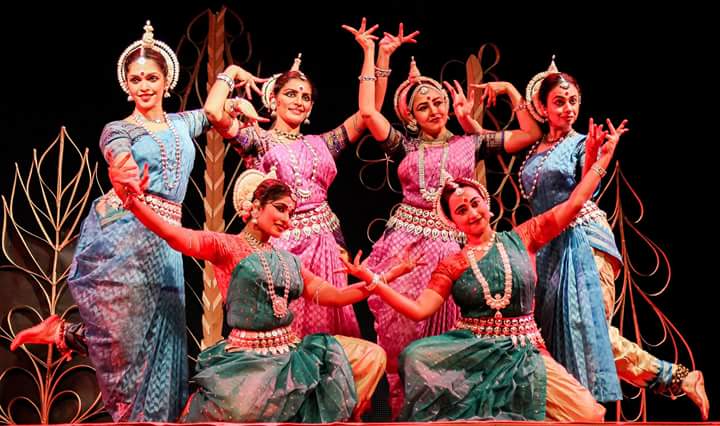
Dance is known to be the best way to express without the need words, yet a better way to convey the unsaid. India, with its great cultural diversity, is the motherland of many popular dance forms. One of the prominent classical dance forms which originated from ancient India is Odissi.
Odissi (or Orissi, as referred to in earlier times) is one of the classical dance forms practiced in India. Its origin story is rather interesting, as it is said to have started in the Hindu temples of Odisha, along its eastern coast. It derives its theory from ‘Natya Shashtra’, which is the ancient Sanskrit treatise on the performing arts. The dance of Odissi is significantly associated with Hinduism, Buddhism as well as Jainism, with its inclusion in the dance postures. It usually has tales of mythical and religious nature along with devotional poems and spirituality, which is then performed by the dancer with the help of emotive expressions, impressive gestures and fluid body language.
The style of the Odissi can be seen as a blend of aesthetics and eye-catching technical details. Tribhangi is one of the primary characteristics of Odissi, with the concept through the body is divided into three parts, head, bust, & torso. Any posture which deals with these three elements is called tribhangi. Similarly, the mudras or “stamp” are equally important which deals with the hand positions signifying various expressions. On one hand, numerous expressions generated through the eyes make the Odissi unique, on the other hand, Liveliness and vibrancy generate a sense of celebration. Thus, Odissi can be termed as a dance form to celebrate Indian spirituality and tradition.
Some interesting facts about Odissi:
-
Not many people know much about Odissi, and hence one would not be able to appreciate this dance form and consequently, the event wholly and perfectly. Here are, therefore, some of the many interesting facts about this beautiful dance form –
-
Odissi is a prominently a dance form for women.
-
Its postures resemble those found in the temple and its sculptures.
-
Odissi is believed to be the oldest and still surviving classical dances of India – its evidence shows that it roughly began in the 1st century BC.
-
It has over fifty mudras – which are nothing but symbolic hand gestures – which are just commonly used. Imagine how many ‘uncommon’ mudras would be in existence.
-
The dance usually focuses the most on Lord Jagannath, who is known to be the Lord of the Universe, particularly worshipped in the originating state of Odisha.
-
Sambalpuri saree and Bomkai saree are the most used attire for Odissi and silver jewelry is used contrary to Gold, as the ornaments to decorate different parts of the body.
Ways to learn and perform Odissi under expert’s guidance in Mumbai
Are you Mumbaikar and still fascinated by Odissi? Would you like your kids to learn the basics of Odissi and eventually perform on stage? If yes, you can avail of the best guidance through Sanyuktam Arts Foundation (SAF). SAF is an organization that teaches young individuals the art form of Odissi, under the guidance of Guru Smt. Debi Basu, India’s one of the leading Odissi teacher and choreographer. SAF has been working hard on enabling the classical dance of Odissi to be appreciated in the wider social circle in India as well as abroad, something which only Bharatanatyam and Kathak gets. The legacy was established nearly 30 years ago, with the scope of the foundation enlarging from just Odissi, to other classical music & other performing arts, specifically from the Indian state of Odisha. It has conducted a lot of events, workshops and presentations, such as ‘Kalanidhi’, ‘Vandana’, and ‘Pratibimba: Reflections of the East’, to name a few.
Many of the passionate individuals have been learning this dance form from this top-class by the name ‘Sanyuktam Arts Foundation’ (SAF). Based in Mumbai, it can be said to be an artistic journey put forth by Guru Smt. Debi Basu, one of the leading Odissi dancers and teachers. She and two others have been shaping young individuals to become an Odissi dancer for decades now. Although the mentors associated with SAF do not need any introductions, who are aware of Odissi, however, let’s introduce them for the sake of completion and for them who are not from the fraternity of Odissi.
• Guru Smt. Debi Basu
Smt. Debi Basu is one of the foremost teachers of Odissi in this generation. The goal of her life is nothing but furthering this classical dance style, simultaneously enriching it. She has been world-famous as a skilled and talented performer and choreographer for more than four decades. It helps that she is deeply fascinated by Sanskrit Literature, mythology and philosophy, because she does an excellent job instilling the art form in her students.
• Smt. Archana Basu
Smt. Archana Basu is also a part of the SAF, along with simultaneously creating her image as a soloist. She has received training under Smt. Debi Basu herself. Yuva Pratibha 2012, Tarang Ratna 2015 and Samsara Youth Samman 2016 are some of the awards she has received for her extensive performances in various festivals spread across India.
• Smt. Anu Narayan
Smt. Anu Narayan is another senior disciple of Smt. Debi Basu for more than 15 years now. Not only this, but she is also an accomplished Bharatanatyam Performer and teacher. What is fascinating about her is the fact she is a graded artist of the Doordarshan, along with being an honorable panelist of the Indian Council of Cultural Relations. She is bestowed with the title of ‘Singar Mani’.


